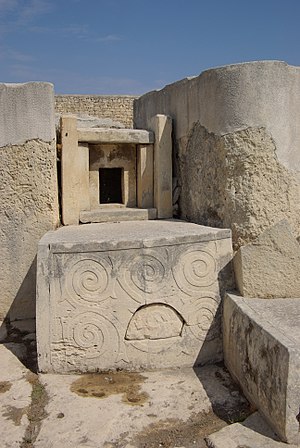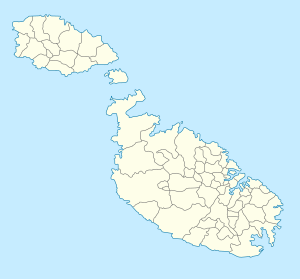Megalithic Temples of Malta
| Megalithic Temples of Malta | |
|---|---|
| Name as inscribed on the World Heritage List | |
 |
|
| Location | Malta |
| Type | Cultural |
| Criteria | iv |
| Reference | 132 |
| UNESCO region | Europe and North America |
| Inscription history | |
| Inscription | 1980 (4th Session) |
| Extensions | 1992 |
The Megalithic Temples of Malta (Maltese: It-Tempji Megalitiċi ta' Malta) are several prehistoric temples, some of which are UNESCO World Heritage Sites, built during three distinct time periods approximately between 3600 BC and 700 BC on the island country of Malta. They have been claimed as the oldest free-standing structures on Earth, although the largely buried Göbekli Tepe complex is far older. Archaeologists believe that these megalithic complexes are the result of local innovations in a process of cultural evolution. This led to the building of several temples of the Ġgantija phase (3600–3000 BC), culminating in the large Tarxien temple complex, which remained in use until 2500 BC. After this date, the temple building culture disappeared.
The Ġgantija temples (two sites) were listed as a UNESCO World Heritage Site in 1980. In 1992, the UNESCO Committee further extended the existing listing to include five other megalithic temple sites. These are Ħaġar Qim (in Qrendi), Mnajdra (in Qrendi), Ta' Ħaġrat Temples (in Mġarr), Skorba Temples (in Żebbiegħ) and Tarxien Temples (in Tarxien). Nowadays, the sites are managed by Heritage Malta, while ownership of the surrounding lands varies from site to site. Apart from these, there are other megalithic temples in Malta which are not included in the UNESCO World Heritage list.
Many of the names used to refer to the different sites carry a link with the stones used for their building. The Maltese word for boulders, 'ħaġar' is common to Ta’ Ħaġrat and Ħaġar Qim. While the former uses the word in conjunction with the marker of possession, the latter adds the word 'Qim' , which is either a form of the Maltese word for 'worship' or an archaic form of the word meaning 'standing'.
...
Wikipedia

